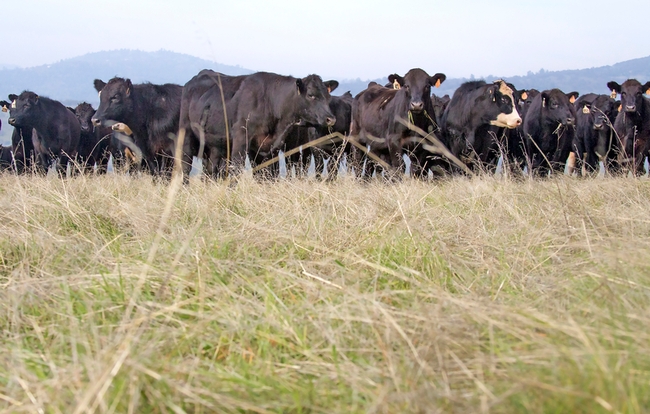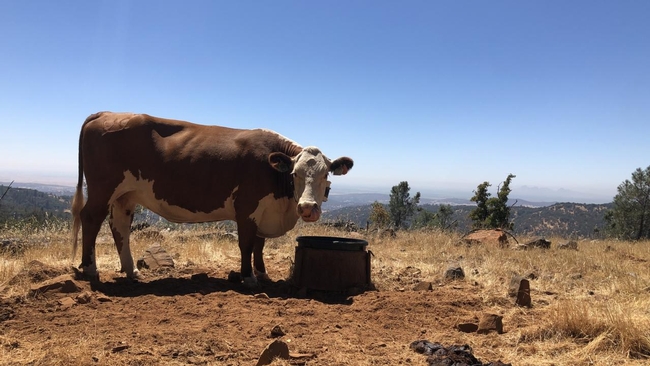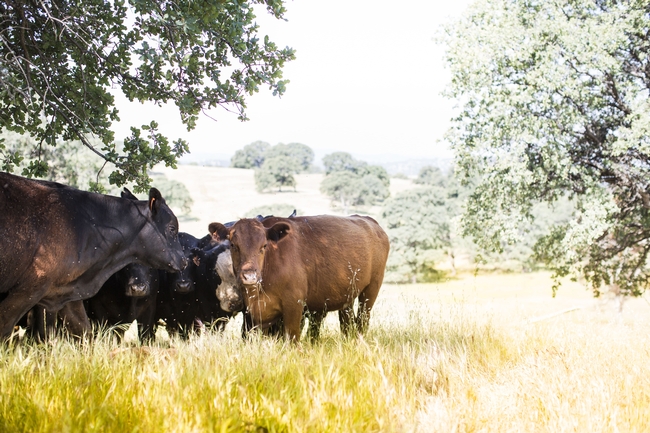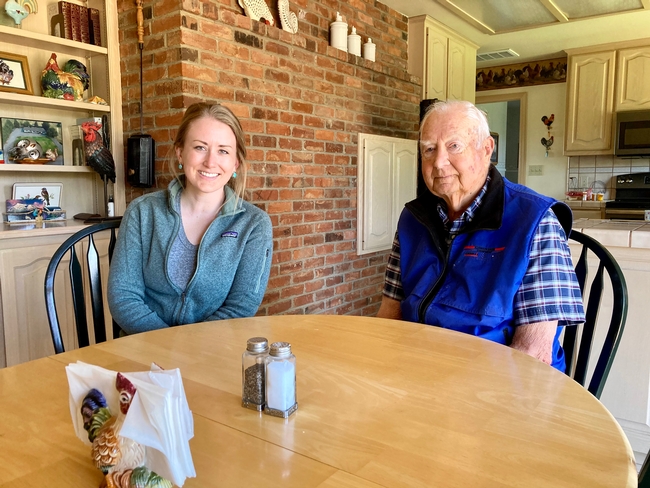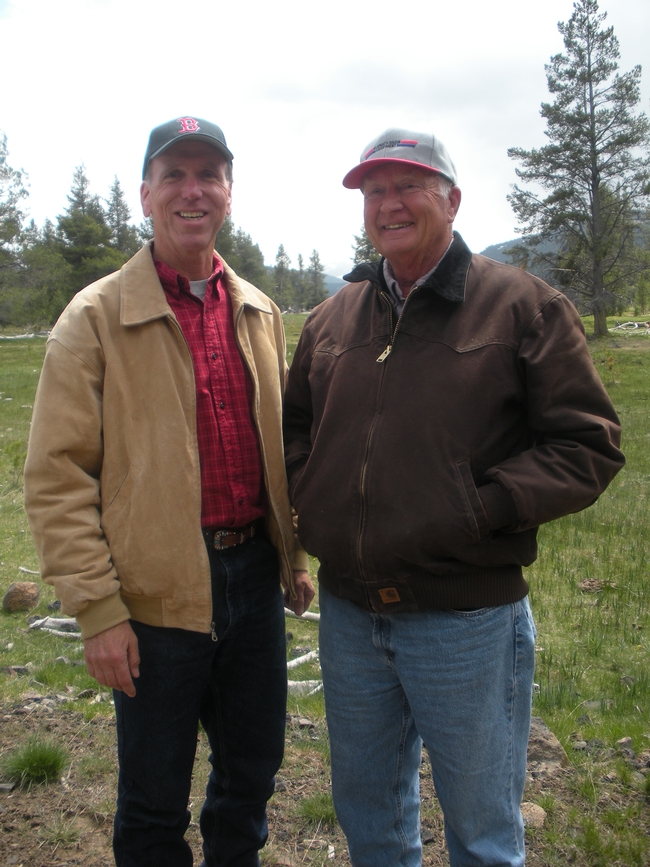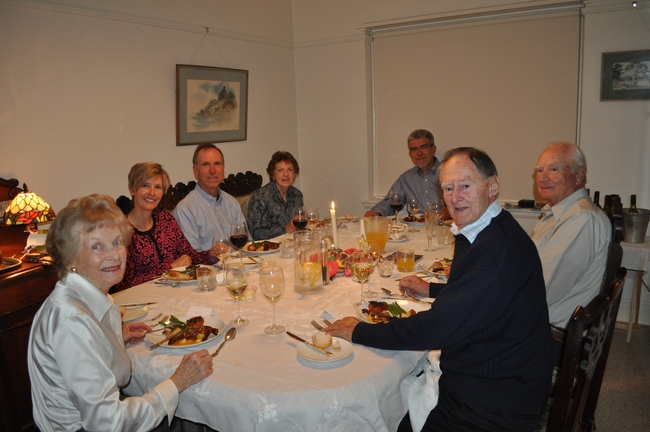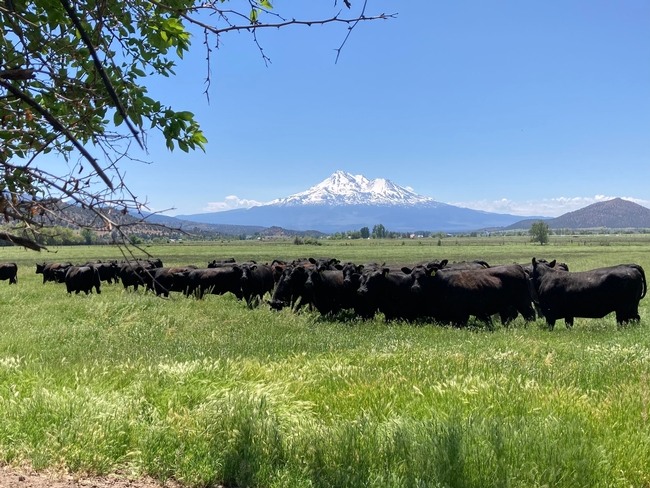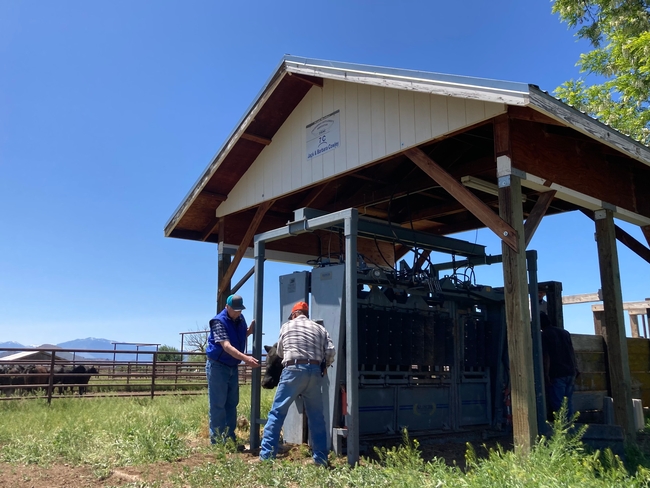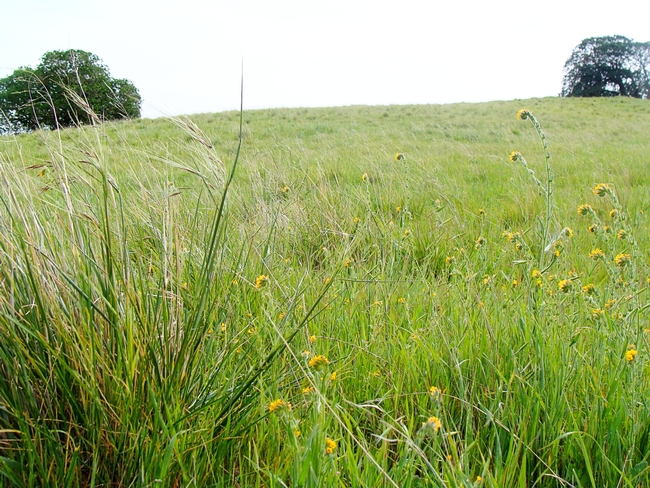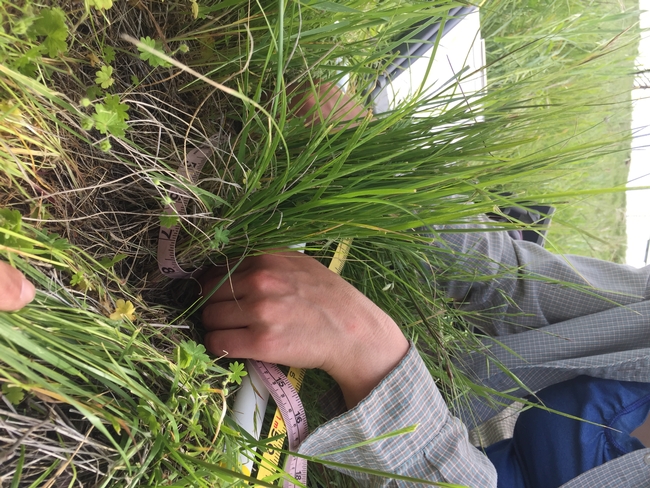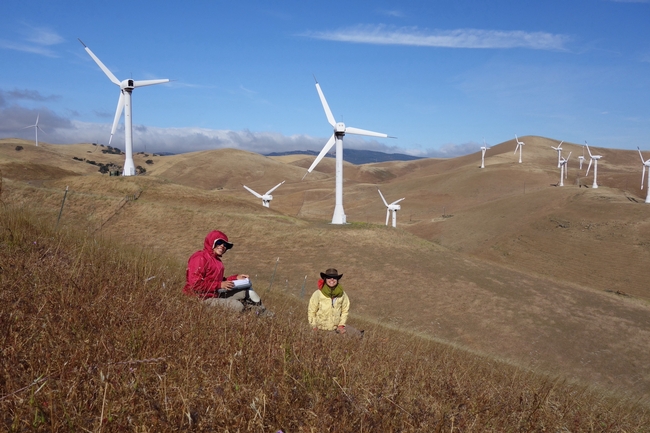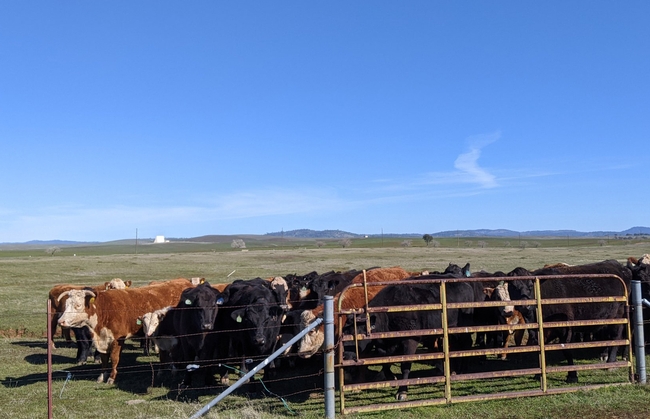
Posts Tagged: cattle
Understanding cattle grazing personalities may foster sustainable rangelands
Matching herds to landscape can support animal growth and ecological needs
Not all cattle are the same when it comes to grazing. Some like to wander while others prefer to stay close to water and rest areas.
Recognizing those personality differences could help ranchers select herds that best meet grazing needs on rangelands, leading to better animal health and environmental conditions, according to a new paper from the University of California, Davis, published in the journal Applied Animal Behaviour Science.
“Cattle can actually be beneficial for the rangelands,” said lead author Maggie Creamer, who recently earned her Ph.D. in animal behavior at UC Davis. “Vegetation in rangelands actually need these kinds of disturbances like grazing.”
Ranchers can add elements to the rangeland such as water, mineral supplements and fencing to influence where cattle graze, but little research has been done on how those efforts affect individual cows. Considering personalities could save money.
“If you're spending all this money to add a management tool in order to change the distribution of your animals, that's a huge cost to ranchers,” said Creamer. “Thinking about other tools, or selecting certain animals with these grazing traits, might be a better way to optimize the distribution on rangeland rather than spending a bunch of money for something that may ultimately not pan out for all your animals.”
Effects of grazing
Livestock graze on an estimated 56 million acres in California, and healthy rangelands host native vegetation and animals, foster nutrient cycling and support carbon sequestration.
Uneven grazing can degrade water quality, soil health and habitats. Optimizing grazing — including the even spread of cow pies — can improve the ecosystem while also reducing fuel loads for wildfires.
To better understand individual grazing patterns, researchers went to the UC Sierra Foothill Research and Extension Center in Browns Valley and tracked 50 pregnant Angus and Hereford beef cows fitted with GPS collars.
The research
The cattle, which were tracked from June to August over two years, had access to 625 acres of grasslands and treed areas ranging in elevation from 600 to 2,028 feet. In the second year, a new watering site was added at a higher elevation.
Across the two years, the cows showed consistent and distinct grazing patterns even when water sources changed. Age and stage of pregnancy did not affect patterns, though cattle tended to clump near water and rest sites on hotter days.
The cows that ventured into higher elevations and farther from watering sites had more variability in their grazing patterns than those that stayed at lower elevations near water. That suggests it may be harder for non-wanderers to adjust to some landscapes.
“Thinking about the topography of your rangeland and your herd of cows can benefit both the animals and the sustainability of the land,” said Creamer, who next month begins work as a postdoctoral scholar in North Carolina.
Gauging personalities
Keying in on personality type may sound difficult, but the researchers also found some clues as to how to pinpoint the wanderers and homebodies. Unlike cattle at feedlots, the breeding cow population, especially on rangelands in California and other western states, live largely “wild” lives and are rarely handled, save for vaccinations and weaning.
Research due to be published later this year found that paying attention to individual cow reactions during those events can help determine personalities. The cows that appeared more passive during those handling interactions tended to be nomadic.
“We found that you can maybe predict those hill climbers if you kind of look at how they act when the veterinarian or rancher handle them,” said senior author Kristina Horback, an associate professor in the Department of Animal Science at UC Davis.
Informing practices
For ranchers, the findings could be invaluable, said Dan Macon, a livestock and natural resources Cooperative Extension advisor in Placer and Nevada counties for UC Agriculture and Natural Resources.
“Any time we can improve our understanding of cattle behavior, particularly at the individual level, it can improve how we handle livestock and manage the landscape,” he said.
Macon said that during the recent drought, it was hard to get cattle into higher country, but if ranchers could have selected the nomads, it may have saved money in terms of ranch labor and other efforts.
“If you ask a rancher who has been attentive to their cattle over many years, they know the personalities,” Macon said.
For Creamer and Horback, the research opens new doors into understanding herd behavior and dynamics, one that could be a cheaper alternative to high-tech solutions.
“Animal science tends to look overlook the mind of the animal when searching for solutions to challenges,” Horback said. “It's always been a direct line to genetics for immunity or nutrition, but nothing about the mind of the animal. And that's such a loss. There's so much we can learn from behavior in the end.”
The Russell L. Rustici Rangeland and Cattle Research Endowment supported the research.
This article was first published on the UC Davis News site.
Fighting fire with feeding
Are cattle a secret weapon for taking on California wildfires?
California's cattle ranchers contribute a significant amount to the region's culture, economy and food supply, but do they also inadvertently help to temper the wildfires that have been plaguing the state? And if so, is it a better alternative – environmentally speaking – to letting grasslands burn?
A new study published in the journal Sustainability delves into the topic, weighing the advantages – and disadvantages – grazing cattle bring to the table. Researchers, including scientists from University of California, Davis and UC Agriculture and Natural Resources, set out to calculate the greenhouse gas emissions of cows consuming vegetation that would otherwise burn in wildfires. Then they estimated the GHG emissions that would result should that forage be untouched and therefore, consumed by fire, eventually comparing the two.
Feeling the burn
Given the severity of California's recent wildfires and the belief they will continue and even escalate in the near future, it's a discussion worth having, said Frank Mitloehner, an expert in animal agriculture and air quality from UC Davis, director of the CLEAR Center and one of the researchers who contributed to the peer-reviewed article.
“Each year from 2010 to 2020, California lost on average 89,000 acres of grassland to wildfires,” said Mitloehner, who is also a Cooperative Extension specialist. “In addition to the obvious disruption and devastation they caused, the fires spewed greenhouse gases and harmful particulate matter such as black carbon into the air and into our atmosphere. Those alone threaten climate health and human well-being.”
A fast and furious gas
Cattle are adept at eliminating herbaceous fuel as they graze. However, at the same time, their specialized digestive system produces methane that is expelled most often in the form of enteric emissions … more commonly known as belches. By way of background, methane is a potent greenhouse gas that warms the atmosphere at 25 times the rate of carbon dioxide over 100 years. But it's only in the atmosphere for 10 to 12 years after it's emitted. Following that, it's broken down into carbon dioxide and water vapor.
For that reason, Mitloehner refers to methane as a “fast and furious” gas. Furious because it warms with a vengeance and fast because it does so for only a short time, especially when compared to carbon dioxide. Furthermore, because of the biogenic carbon cycle, whereby plants extract carbon dioxide from the atmosphere for photosynthesis, the warming of methane and its byproducts can end entirely when it's hydrolyzed and used by plants.
How researchers calculated emissions
In order to determine if grazing, methane-emitting cattle are better for the atmosphere than burning grasslands, Mitloehner and the other researchers employed a method known as “Monte Carlo simulation,” a mathematical technique used by scientists to predict outcomes of an uncertain event.
Looking exclusively at methane emissions, they found it's better to have cows eat vegetation than to have wildfires burn it. Granted, it's only marginally better, but when one considers other advantages of animal agriculture and conversely, other disadvantages of widespread, uncontrolled fire, the conversation suddenly shifts.
“Even if cattle provided no other benefit to us, which certainly is not true, we can now make the case that they are helpful to us in yet another way,” Mitloehner said.
Friends or foes?
It goes without saying that one would be hard pressed to find much good to say about wildfires, but that doesn't hold true for animal agriculture. The industry provides jobs and supports the economy in other ways as well. Plus, it is a major source of protein-rich food that is in increasing demand as the world's population continues on a trajectory toward 10 billion people by the year 2050.
Where global warming is concerned, the industry is in the unique position of being able to reach net-zero warming, also known as climate neutrality, if it continues to aggressively chip away at its methane emissions, which Mitloehner asserts is of critical importance to the planet. “Few other sectors can reduce its warming to net zero and still be of service to society, but agriculture can because of the way methane behaves in the atmosphere,” he says.
To be clear, grazing cows are no match for wildfires. Yet, in addition to everything else the sector does for us, slowing the burn and keeping relatively more methane from entering the atmosphere are not nothing.
In addition to Mitloehner, authors of the study are Cooperative Extension advisors Sheila Barry, Devii Rao and Theresa Becchetti; Rowan Peterson, Ermias Kebreab and Minju Jung of UC Davis; and Felix Ratcliff and Kaveh Motamed of LD Ford.
This article was first published on the website of the CLEAR (Clarity and Leadership for Environmental Awareness and Research) Center at UC Davis.
Cattleman’s four decades of UCCE collaborations advance ranching practices
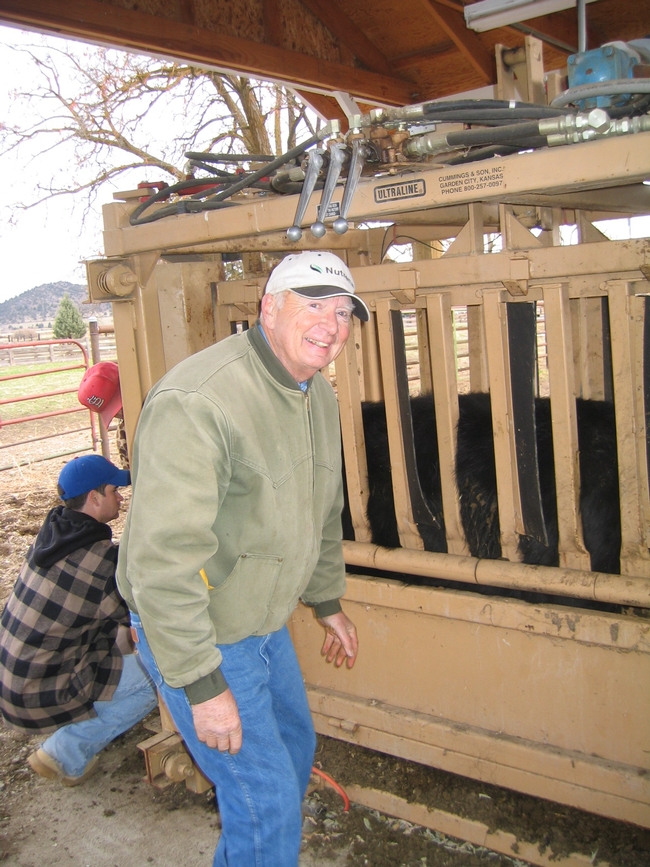 Siskiyou County rancher Jack Cowley has collaborated with UC Cooperative Extension scientists on research projects ranging from weed control to cow genetics for 40 years. The cooperation of farmers and ranchers is critical for producing practical research, scientists say. Photo by Alison Van Eenennaam
Siskiyou County rancher Jack Cowley has collaborated with UC Cooperative Extension scientists on research projects ranging from weed control to cow genetics for 40 years. The cooperation of farmers and ranchers is critical for producing practical research, scientists say. Photo by Alison Van Eenennaam

Eye doctor-turned-rancher brings science background to his second career
Siskiyou County rancher Jack Cowley, 91, joyfully recalled the special Christmas gift that delighted his seven children in the 1960s. Cowley, then a practicing eye doctor in Sacramento, and his late wife Barbara surprised the children with a white quarterhorse, which they named Silver.
“That's how it all started!” exclaimed Cowley, reflecting on the gift horse that would eventually lead to a 40-year collaboration with University of California Agriculture and Natural Resources.
Silver was the impetus for his family's involvement with the 4-H Youth Development Program, a part of UC ANR. Cowley also would later transition to a second career in cattle ranching, and collaborate with UC Cooperative Extension on research projects ranging from weed control to cow genetics.
“Jack has been an extremely committed supporter of UCCE,” said Grace Woodmansee, who became the UCCE livestock and natural resources advisor for Siskiyou County in 2021. “He has worked with UCCE extensively and contributed a lot of time and resources to supporting local and statewide projects.”
Lately Cowley and his son David have been working with Woodmansee and Gabriele Maier, UC Cooperative Extension specialist in the UC Davis School of Veterinary Medicine, on a cow deworming study.
Not only has Cowley allowed UCCE scientists to study his cattle over the years, he has been willing to personally share information with scientists and cattle producers across the country and internationally.
“It is important to foster exchange and linkages, said Dan Drake, UCCE farm advisor emeritus in Siskiyou County, who collaborated with Cowley for 30 years. “He went to so many meetings, especially with the early and uncharted areas of cattle genetics. Jack was on a first-name basis with the leaders from other states and the relationships were important in both directions. Frankly, I think many of those folks were jealous of the great cooperator we had in California.”
Breeding for better beef
After retiring from his Sacramento ophthalmology practice in the 1990s, Cowley settled in Montague in Siskiyou County, 246 miles north of the closest UC campus. There he met then-UC Cooperative Extension farm advisor Steve Orloff and Drake. Orloff advised him on alfalfa production and pasture management while Drake offered counsel on animal health records, organizing breeding, animal nutrition and water issues.
Drake explained to ranchers that by selectively breeding cows based on genetics, they could improve the production and quality of beef so that it's healthier for humans.
“My medical background helped me understand animal genetics,” Cowley said. “We can modify the genetics to improve the quality of the beef to make it more heart-healthy.”
In 2009, Drake introduced Cowley to UC Cooperative Extension specialist Alison Van Eenennaam, who studies animal genetics at UC Davis.
“I was looking to set up a research trial where we would follow cattle from the ranch all the way through to the Harris Ranch processing plant in the Central Valley,” said Van Eenennaam, who worked with Cowley on a three-year project.
Using DNA samples from Cowley's cattle, they evaluated the data they received from processor Harris Ranch of the beef characteristics – such as tenderness -- to compare the different breeds.
“I really thought I knew what I was doing and my cattle graded terribly,” Cowley said.
Since beginning the genetics project, his beef quality steadily improved.
“We're now up to where all of our animals are graded anywhere from 20% to 40% Prime and the rest Choice,” said Cowley, adding that he stopped striving for higher grades because the buyer said there was a limited market for the more expensive meat.
Cowley takes pride in knowing breeding practices developed from the research he and UC Cooperative Extension conducted have been adopted globally by dairy producers and beef producers.
“The type of research we were doing there has eventually evolved to now we have these genomic tests that you can use that genetically predict the performance of animals,” Van Eenennaam said. “Nowadays people just take an ear tag and send it in and get their genetic prediction.”
Van Eenennaam credits Cowley for allowing research on his large herd. “Jack was very patient with things that take a long time. When researchers come onto your ranch, that could slow you down.”
She added, “Genetic improvement, of course, is a huge component of sustainability because the more efficient cattle are, the less feed they consume and the less time they take to finish, which ultimately lessens their environmental footprint.”
Growing up in Utah
Looking back, Cowley marvels that he has been fortunate to do what he wanted to do in life.
“I was interested in ranching when I was probably seven or eight years of age,” said Cowley, who delivered the local Deseret Newspaper on horseback as a boy. “I grew up in Utah, you know, a little town in Utah called Holladay. It was not a ranching community.”
After serving four years in the Air Force during the Korean War, he returned to Utah to find the cute girl he met in first grade had graduated from college and was still single. He married Barbara in 1956. When he was accepted at George Washington University medical school, they drove with their three-week-old baby from Utah to Washington, D.C. He got a job in the Senate office building as an elevator operator working from 5 to 11 p.m., which enabled him to study, meet influential people and finish medical school without debt.
“I actually got to meet Khrushchev,” he said, recalling his encounter with the Soviet leader..
After finishing his ophthalmology residency at UCLA, Cowley established his practice in Sacramento and later taught a few classes at UC Davis Medical School.
Becoming a cattleman
One Saturday afternoon, after Silver the horse joined the family, Cowley and his oldest daughter, Kathryn, were driving in Placerville and saw a ranch for sale. He bought the 90 acres. For two summers, Barbara and the children lived at the ranch and Cowley joined them on weekends.
“Of course, I had to have a few cows to play with,” he said with a chuckle. “Basically, I thought I could make some money off of 50 cows.”
As his herd grew, he moved it to Corning, 50 miles south of Redding, and finally to the site in Montague that could accommodate several hundred head of cattle. “That's when I really became interested in animal genetics,” Cowley said. “That was back when we had slide rules to do our calculations. It was pretty crude, but it was a start.”
In 1990, Cowley was honored as the California Beef Cattle Improvement Association's Seedstock Producer of the year and, in 2007, was named Siskiyou County's Cattleman of the Year. He has served as president of the Siskiyou County Cattlemen's Association, on the Cattlemen's Beef Board, as well as on committees for the National Cattlemen's Beef Association.
“Jack spent countless hours traveling to the Midwest and other beef research institutions to share knowledge, learn more and plan for needed information,” said Drake, emeritus UCCE livestock advisor. This made for better Extension work, better research and recognition of UC Cooperative Extension work nationwide.”
In 2011, when Van Eenennaam and Drake presented their research at an international genomics conference, he joined them in Australia to learn from other researchers. They also visited Australian producers to learn their practices.
“We really rely on cooperators like Jack to enable our research to have translation to farmers and ranchers,” Van Eenennaam said.
In recent years, Cowley has handed the ranch reins over to his children David, Brian, Brent and Kathryn, who live in Siskiyou County.
David, who retired from a nearly 40-year career as a software engineer, plans to continue working with UC Cooperative Extension advisors and specialists.
“Any time you have questions, you can call and they're more than happy to help you,” he said.
The no-tech way to preserve California’s state grass
Disappearing native is like an environmental Swiss Army knife
Though it is disappearing, California's official state grass has the ability to live for 100 years or more. New research demonstrates that sheep and cattle can help it achieve that longevity.
Purple needlegrass once dominated the state's grasslands, serving as food for Native Americans and for more than 330 terrestrial creatures. Today, California has lost most of its grasslands, and the needlegrass occupies only one tenth of what remains.
It is drought resistant, promotes the health of native wildflowers by attracting beneficial root fungi, burns more slowly than non-native grasses and speeds the postfire recovery of burned lands. For these and other reasons, many who work toward habitat restoration hope to preserve the needlegrass.
“Where it grows, these tall, slender bunches become focal points, beautiful as well as environmentally beneficial,” said Loralee Larios, a UC Riverside plant ecologist affiliated with UC Agriculture and Natural Resources. “However, identifying successful management strategies for a species that can live for a couple hundred years is challenging.”
To meet that challenge, Larios teamed up with University of Oregon plant ecologist Lauren Hallett and Northern California's East Bay Regional Park District. They tracked the health of nearly 5,000 individual needlegrass clumps over six years, including an El Niño rain year as well as historic drought.
The researchers took measurements of plant health including growth and seed production. They placed small bags over many of the grass clumps to capture the seeds and quantify the number of seeds they produced.
Their findings, now published in the Journal of Applied Ecology, were that purple needlegrass did better in places where sheep were allowed to graze. The positive effects of the grazing were amplified in times of wetter weather.
Previously, the park district spent a decade trying to assess the success of its grassland maintenance techniques. However, the district's method of applying a strategy like grazing, and then measuring the percentage of needlegrass clumps in a given area resulted in data that didn't follow a discernable pattern from year to year.
“By tracking each plant over time, rather than scanning broadly across an area, we gained much more clarity about how the grass responds to the grazing,” Larios explained. “Perhaps counterintuitively, we saw that the needlegrass generally died back when sheep weren't allowed to graze on it.”
When sheep were removed from the study sites, the needlegrass in all but two of the sites became less healthy. The researchers would like to learn whether the two sites that remained healthy have needlegrasses that are genetically distinct.
Grazing is a controversial strategy for grassland restoration. Some conservationists believe sheep eating the target grass, particularly during already stressful drought years, does not enhance their survival. As far back as the 1800s, some researchers hypothesized that the combination of grazing and drought resulted in the loss of perennial grasses.
Though drought was not beneficial for any of the plants in this study, the researchers believe grazing helped needlegrass survive in at least two ways. One, by trampling on leaf litter and other organic debris, sheep created space for new needlegrass to grow.
“Sometimes you get litter that's as deep as a pencil — so much dead, non-native grass piles up. It's hard for a little seed to get enough light through all of that,” Larios said.
Secondly, sheep eat non-native grasses that generate growth-suppressing debris and compete with purple needlegrass for resources.
When the Spanish colonized California, they brought forage grasses like wild oats that they thought would benefit cattle. Those introduced grasses spread, and now dominate the state's grasslands.
“Our grasslands are known as one of the world's biggest biological invasions,” Larios said.
California has as many as 25 million acres of grasslands, equivalent to the combined areas of Massachusetts, Connecticut, and Rhode Island. Though Larios does not believe it is possible to rid the state of all non-native grasses, she said it is possible to maintain or even increase the amount of purple needlegrass.
“It's great for carbon storage, which mitigates climate change, it doesn't serve as wildfire fuel, and cultivates a space for wildflowers that pollinators are then able to use,” Larios said. “We want to keep all those benefits.”
Cattle health webinars now online
University of California Cooperative Extension and UC Davis Veterinary Medicine are sharing recordings of their March 2022 cattle health webinar series for California cattle ranchers. This series was co-hosted by UC Cooperative Extension advisors Tracy Schohr, Grace Woodmansee and Rebecca Ozeran and UC Cooperative Extension specialist Gabriele Maier.
“Last month hundreds of cattle producers joined us for evening webinars that took a deep dive into a cross section of important cattle health topics,” said co-host Schohr, UC Cooperative Extension livestock and natural resources advisor in Plumas, Sierra and Butte counties.
“We recognize cattle producers have busy lives with off-ranch careers and family responsibilities that can make it difficult to attend in-person continuing education events,” she said, “so we hosted the online webinar series and have recorded them so more producers can take advantage of these comprehensive resources on cattle health and production.”
The video recordings and additional resources from the webinar series can be found at ucanr.edu/sites/Rangelands/CattleHealth. The video topics and featured speakers include:
- Whole Herd Health Plans and Vaccination Schedules - Gabriele Maier, UC Cooperative Extension specialist for beef cattle herd health and production at UC Davis, and Tom Talbot, a large animal veterinarian in Bishop
- Herd Bull Health, Diseases and Injuries - Bret McNabb, DVM, UC Davis School of Veterinary Medicine
- Pinkeye in Cattle - John Angelos, professor in UC Davis School of Veterinary Medicine
- Toxic Plants and Livestock - Robert H. Poppenga, DVM, Ph.D., DABVT, Head Toxicology Section, California Animal Health and Food Safety Laboratory, UC Davis School of Veterinary Medicine
- Why Did it Die? California Animal Health Food Safety Laboratory - Maier and Katherine Watson, anatomic pathologist at California Animal Health and Food Safety Laboratory.
“The past two years, Cooperative Extension has pivoted the way we have shared information with livestock producers with the cancellation of in-person events, allowing us to focus on new outreach tools,” said Maier. “We saw tremendous engagement with our live online Beef Quality Assurance trainings that led the team to host the series this March, focusing on topics attendees had expressed an interest in during the BQA Training. The videos provide a resource for livestock producers to continue to improve the health of their cattle and increase beef production on their ranch.”
For questions or suggestions on future topics, please contact Schohr at tkschohr@ucanr.edu.

